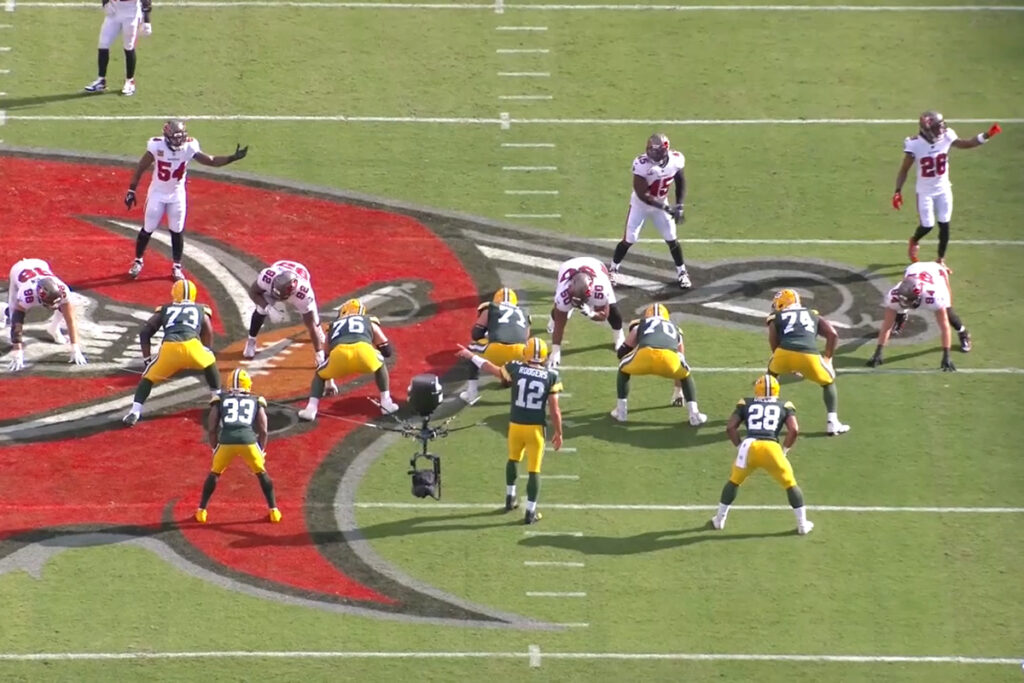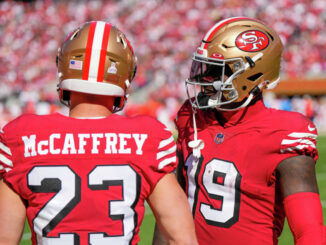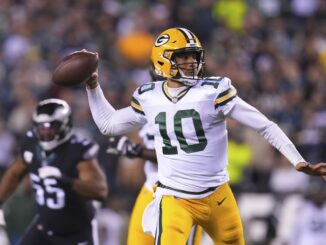
One of the big questions facing the Packers over the offseason was how their offense would look without Davante Adams. The answer through four games, is very different. One thing we have seen a lot more of is the fabled Pony personnel. So, what exactly is it, and how have they been using it? Let’s dive into the film and find out.
What is Pony personnel?
You’ve probably heard broadcasters mention Pony personnel. As with all of these football terms, its meaning is pretty simple. Pony simply refers to any personnel grouping that includes two running backs. This is different from the traditional 21 personnel that was the standard in the NFL for many years as that includes a running back and a fullback. With Pony, it is two true running backs on the field simultaneously. For the Packers that means that both Aaron Jones and A.J. Dillon.
The term itself is a reference to the famous SMU Mustang college teams of the early 1980s. Their offense was built around their “Pony Express” rushing tandem of Eric Dickerson and Craig James. The two players were almost unstoppable, combining for a ridiculous 5,130 rushing yards at 5.6 yards per attempt over the course of two seasons from 1981-82.
What are the advantages of Pony personnel?
Now we know what Pony personnel is. The next question is why offenses would want to run it. In the case of the Packers, there is the simple fact that getting their best 11 players on the field involves both Jones and Dillon. There is a little bit more to it than that though.
Running Pony personnel provides a number of schematic advantages to the offense. The biggest one is the mismatch in personnel groupings. With the passing game becoming more and more important and offenses utilising three receivers, defenses have sought to counter this with more defensive backs. Whereas 20 years ago teams routinely came out in base personnel (four defensive backs), nickel (five defensive backs) is now the go-to personnel grouping for defenses. In 2021, defenses ran nickel on 61.4% of plays, setting an NFL record.
For many defenses, nickel is the new base and it what they are most comfortable in. This is where Pony causes problems. If defenses decide to stay in nickel packages, the offense has two legitimate rushing threats that can grind down their opponent on the ground. It also causes problems when defenses seek to defend it with base personnel, as both running backs are legitimate receiving threats who present mismatches if left one-on-one against a linebacker.
The other key benefit of Pony personnel is that it keeps defenses guessing in the running game. One of the limitations of the modern shotgun offense is that it limits the options for the running game. Defenses can generally tell where a running back will attack based on which side of the quarterback they line up. When you come out in Pony personnel, there are two rushing threats that can attack both sides of the defense. That uncertainty for the defense presents an obvious advantage to the offense.
So now we know what it is and why teams would use it. With that out the way, let’s take a look at three of the ways that the Packers have employed Pony personnel so far this season.
Split back sets
Green Bay have employed Pony personnel in a number of ways but using split back formations has been by far their most common. If you’ve watched any Packers games so far this season you will have seen them run this multiple times. They will add wrinkles to the formation, but at its core it involves the quarterback in the shotgun formation, with the two running backs either side of him.
Their favourite play out of this formation is an Outside Zone RPO with a swing screen. As with all RPOs, the quarterback has the ability to throw the ball or hand it off depending on the matchup. You can see an example of how this works in the clip below against the Bucs.
Rodgers is responsible for reading the matchup at the top of the screen. What he is looking for is a numbers advantage. If the Packers have more players to the swing side than the defense do, he will throw the ball. If the defense has the numbers advantage or the balance is even, he will hand the ball off. You can see here that Lavonte David (#54) follows Dillon on the swing route, leaving a 3-on-3. Rodgers hands the ball to Jones instead for a 10-yard gain.
In the next clip against the Vikings, you can see what happens when the defense overcommits to the run. With Danielle Hunter (#99) walking up to the line, Rodgers knows he has the numbers advantage to the bottom of the screen. The potential for a run also holds Vikings linebacker Eric Kendricks (#54) for a split second, meaning he is late to react to the pass. This gives the Packers the numbers advantage they need and Rodgers makes the throw to Dillon, who picks up nine yards.
What makes this play so interesting is the infinite wrinkles and variations that the Packers can sprinkle in. This is a staple play in the Packers offense so Matt LaFleur knows defenses will be ready for it. He therefore mixes things up slightly from week to week to keep his opponents honest.
Take this next play against the Bears in Week 2. When the play starts off it all looks familiar. The Packers are once again in their Gun Split Flex formation and Dillon once again goes out on the swing route. You can see the Bears defense identify the play and make sure to commit enough bodies to the bottom of the screen. That’s when it changes. Instead of running outside zone, the Packers have called a screen pass to Aaron Jones on the other side. It catches the Bears defense off-guard and Jones scampers for a 15-yard gain.
On this one they mix things up even more. The Packers send Marcedes Lewis (#89) in motion across the formation before the snap. Instead of putting A.J. Dillon on a swing route, this time he runs in front of Rodgers and across the formation on a flat route. On the front side of the play they have also mixed up the call. Instead of running a straightforward outside zone run, the Packers are running another favourite – the pin-pull. All of this eye candy and moving pieces causes havoc for the defense and Jones picks up eight yards.
Backs out wide with motion
Whilst the split back formation is the Packers’ bread and butter in Pony personnel, that isn’t all they do. One thing they love to do is get Aaron Jones lined up out wide, before being used in motion across the formation.
On the play below against the Vikings you see Jones come in motion from the top of the screen. The Packers’ offensive line then does a great job of selling the play action, which draws the linebackers in and leaves Robert Tonyan wide open for a 23-yard gain.
LaFleur’s ability to mix things up shows again here in a play the following week against the Bears. The Packers are in a condensed formation, but once again Jones is the outside receiver to the trips side, with Watkins as the X receiver to the bottom of the screen. Once Jones goes in motion you can bet that the Bears defense is expecting the Packers to run the same play that they saw the week before. Instead, Jones gets the ball on a pop pass, with Dillon coming out of the backfield as a lead blocker. The play works beautifully, and Jones gets into the end zone for a touchdown.
They added another wrinkle to the same look against the Patriots in Week 4. Whilst the result of this one is comparatively modest, it once again shows the multitude of ways in which LaFleur and the Packers are able to scheme up opportunities in Pony personnel. Jones’ motion gets the defense flowing to the right, giving Dillon room to attack the other side.
Getting five out
Whilst much of the success of Pony personnel has predictably come through the running game, LaFleur has also shown the ability to use it in the passing game. Both Jones and Dillon have proven themselves to be competent receivers and are key parts of Green Bay’s passing game. The two finished second and sixth on the team in targets last season. Through four games this season they sit third and fifth respectively.
I’ve already mentioned how the Packers will punish teams who want to live in nickel packages. With this play you get to see what happens when defenses try instead to stop the run. The Patriots line up with eight defenders in the box. Though they are technically in nickel, they are playing with three safeties – this is known as “big nickel”. One of those safeties is Kyle Dugger, who is built more like a linebacker at 6’0″ and 220 lbs. Green Bay takes advantage of this, getting all five eligible receivers out into their routes.
With the defense stacking the box, Rodgers knows he has the right matchup in the passing game. Notice how Jones occupies Adrian Phillips (#21). This creates a hole in the coverage, which Rodgers exploits with a beautiful throw to Lazard for a 24-yard gain.
The versatility in how the Packers can use Pony personnel shows up nicely on this last play against the Bucs in Week 3. Once again the defense is matching them with big nickel. The Packers respond by spreading the formation out this time, running an Empty Double Wing formation. They are running a screen here and Rodgers once again spots the number advantage to the top of the screen. He gets the ball to Jones, who picks up eight yards.
Pony personnel isn’t anything new, but the way that Green Bay is using it certainly is. Whilst the foundations of their plays remain pretty simple, the infinite variations and adjustments that they are making week-to-week is keeping defenses guessing and putting them at an advantage. I can’t wait to see how their usage evolves as the weeks go by.


